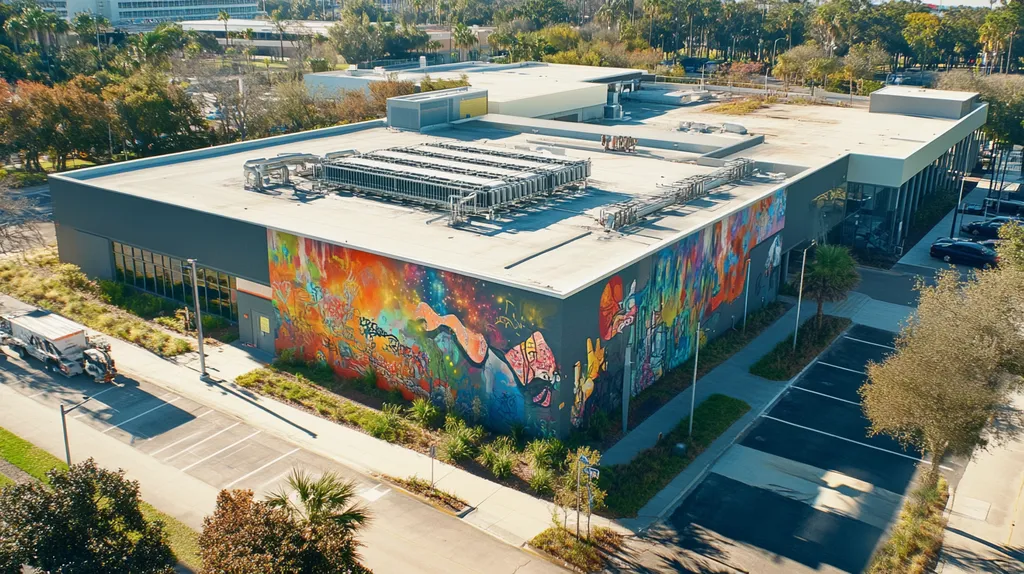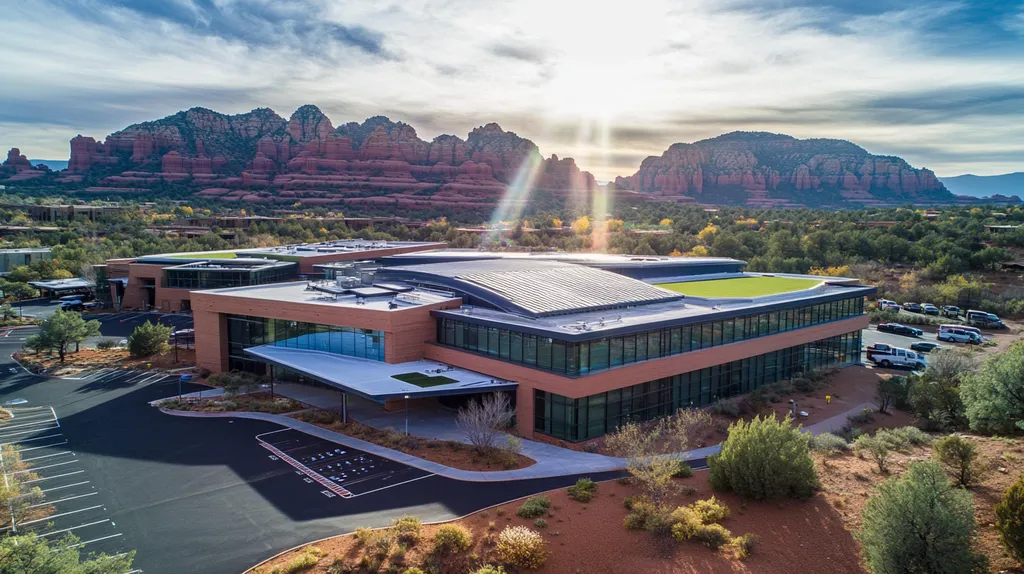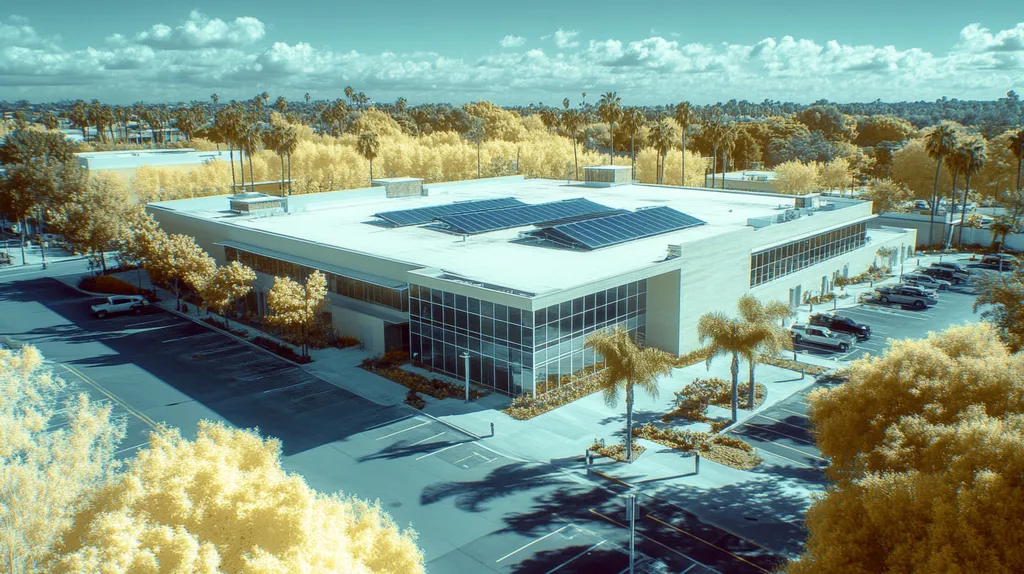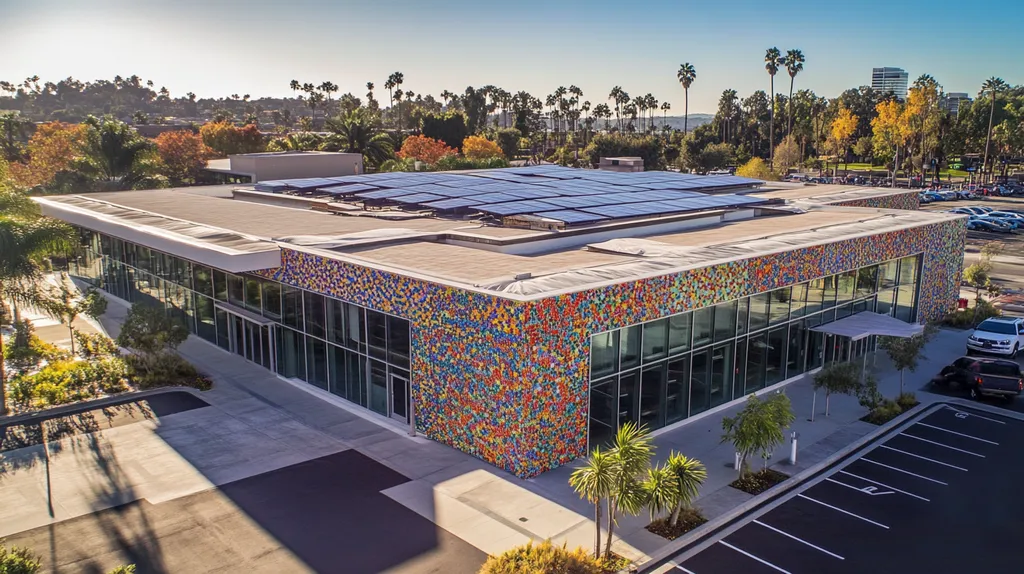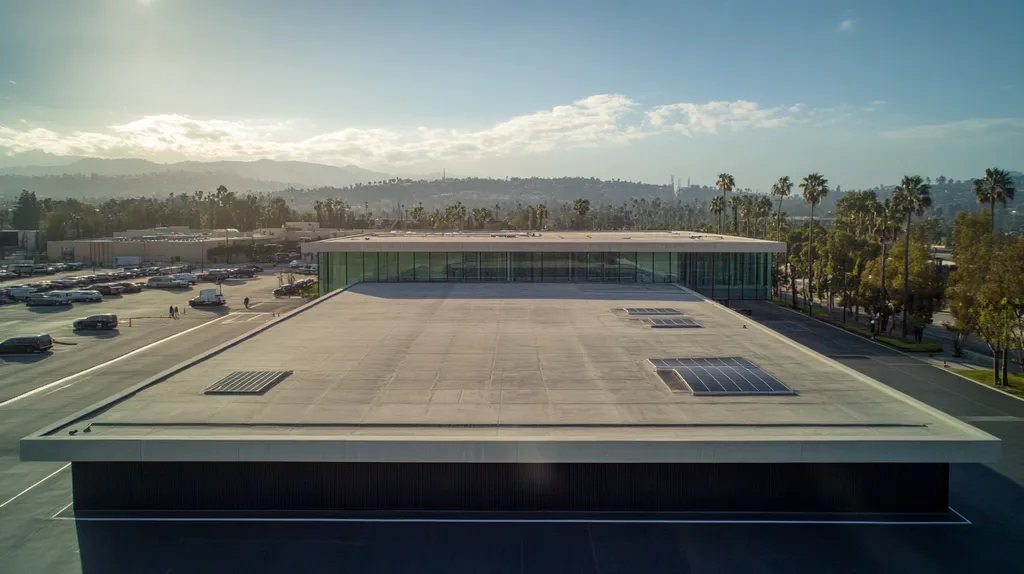In today’s competitive commercial real estate market, energy costs can make or break a property’s profitability. The U.S. Department of Energy reports that buildings without proper roof insulation and reflective coatings waste up to 40% more energy on cooling costs.
While traditional roofing focuses mainly on weather protection, modern insulation with reflective coatings transforms your roof into an active energy management system. Think of it as giving your building a high-tech shield that reflects heat while keeping the cool air where it belongs—inside!
This comprehensive guide explores everything from fundamental concepts to optimization strategies, helping property owners and facility managers navigate the exciting world of reflective roof coatings. After all, your roof shouldn’t just sit there looking pretty—it should work as hard as you do!
SECTION 1: FUNDAMENTAL CONCEPTS
As energy costs continue to climb and the push for sustainability gains momentum, reflective coatings for commercial roofs have become more than just an option; they are now essential. A remarkable finding from the U.S. Department of Energy shows that reflective roofs can cut cooling costs by an impressive 30%. This section delves into key concepts like reflectivity, the different types of coatings available, and their resistance to UV rays and heat. Grasping these fundamentals will empower property owners and facility managers to make informed, energy-efficient roofing decisions.
Reflectivity and Energy Efficiency
Reflectivity is more than just a buzzword; it’s a game-changer for energy efficiency. How well a roof reflects sunlight can drastically alter the amount of heat it absorbs, influencing cooling energy consumption. Buildings without adequate reflectivity tend to trap heat, causing internal temperatures to skyrocket during warmer months, which in turn ramps up the demand for air conditioning.
Research indicates that choosing the right reflective coating can substantially boost a roof’s Solar Reflectance Index (SRI), yielding a cooler and more energy-efficient system. For example, some commercial roofs achieve SRI values exceeding 100, showcasing excellent heat reflectance. This not only trims energy consumption but also prolongs the lifespan of roofing materials.
Additionally, adopting reflective coatings can ensure compliance with local energy codes promoting efficiency. Facilities investing in these upgrades frequently report serious savings in operational costs, enhancing their overall financial health.
Consequently, picking the right reflective coating can translate into significant long-term financial advantages, minimizing not only energy bills but also future maintenance and replacement expenses.
Types of Reflective Coatings
Navigating the variety of reflective coatings available is crucial for selecting the best option for specific roofing systems and performance needs. Popular types comprise acrylic, silicone, and urethane coatings, each bringing distinct properties suited for different climates and building materials.
Acrylic coatings are favored for their water-based nature, straightforward application, and robust reflectivity. They also offer excellent UV resistance, making them a cost-effective choice for a wide range of roofing systems. In contrast, silicone coatings excel in waterproofing and flexibility, making them ideal for regions prone to severe weather.
On the higher end, urethane coatings, while typically pricier, deliver outstanding durability and foot traffic resistance. Their superior reflectivity makes them excellent for high-performance applications. By understanding these options, property owners can select materials that align with their operational requirements.
Ultimately, the right coating choice not only boosts energy efficiency but also enhances roof durability and longevity, adding to the property’s value.
UV and Heat Resistance
The capacity of reflective coatings to resist UV rays and heat is vital for preserving roof integrity. UV radiation can gradually damage roofing materials, culminating in cracks and curls that compromise performance. Reflective coatings are engineered to endure this exposure, extending the roof’s service life.
Managing heat resistance is equally essential. Roofs with effective heat management reduce strain on HVAC systems, thereby lowering energy costs. Coatings characterized by excellent heat resistance maintain cooler surface temperatures, enhancing comfort levels indoors.
Many top-tier reflective coatings incorporate cutting-edge thermal management technologies that fortify their performance against extreme temperature changes. For instance, coatings infused with specialized polymers can drastically enhance both UV and heat resistance.
Investing in high-quality coatings that provide superior UV and heat protection can drastically cut maintenance costs and extend the life of the roofing system, ensuring that commercial properties operate efficiently in the long run. This is particularly critical in a competitive market where efficiency is paramount.
SECTION 2: SYSTEM COMPONENTS
Understanding the components of insulation with reflective coatings is essential for commercial property owners and facility managers. Selecting the right materials can significantly boost energy efficiency, prolong the lifespan of roofs, and trim operational costs. In fact, studies reveal that reflective coatings can lower roof temperatures by as much as 30%! This section unpacks the various types of coatings available and highlights their unique benefits.
Acrylic and Silicone Coatings
Acrylic and silicone coatings have gained popularity for their robust UV resistance and impressive durability. Acrylic coatings are not only water-based, making them a breeze to apply, but they are also environmentally friendly. Their ability to reflect sunlight helps reduce cooling costs, especially during scorching summer months.
On the flip side, silicone coatings shine in waterproofing, thanks to their remarkable flexibility and strong adhesion in extreme weather. This is especially beneficial for roofs that face dramatic temperature shifts or heavy downpours.
Both options positively contribute to a building’s energy efficiency. However, it’s important for property owners to assess climate-specific needs to make informed decisions.
Urban areas can also benefit aesthetically from the bright, light-colored nature of these coatings, which can elevate a building’s visual appeal. This added advantage may boost marketability and increase overall property value.
Polyurethane and Thermoplastic Coatings
Polyurethane coatings stand out thanks to their exceptional durability and resistance to foot traffic and chemicals. They are perfect for roofs that require a heavy-duty solution. Not only are they tough, but they also provide excellent thermal insulation, contributing to energy efficiency.
Meanwhile, thermoplastic coatings, like PVC and TPO, are becoming increasingly popular. These materials offer impressive heat and corrosion resistance, making them ideal in challenging environments. Their capacity for heat-welding creates seamless transitions, which significantly reduces the risk of leaks.
Both polyurethane and thermoplastic coatings enhance energy efficiency due to their reflective properties. They also simplify maintenance, making it easier to keep rooftops accessible and operational without significant interruption.
Furthermore, their customizable nature allows for tailoring solutions to meet specific building requirements, enhancing their attractiveness for property owners.
Spray Foam and Elastomeric Coatings
Spray foam is an innovative insulation material that expands upon application, ensuring a tight seal against air and moisture infiltration. This feature not only amplifies energy efficiency but also provides soundproofing benefits. The insulating properties of spray foam can lead to notable savings on heating and cooling expenses.
Elastomeric coatings offer the flexibility of a rubber-like finish that accommodates the natural movements of buildings. They create effective seals against leaks and gaps, forming a continuous barrier against moisture that can significantly prolong the roofing system’s life.
Both spray foam and elastomeric coatings excel in preventing roof degradation with their waterproof qualities, making them vital in areas subjected to severe weather where traditional roofs may falter.
When applied correctly, these advanced systems can lead to lower maintenance costs over time, freeing property managers to concentrate on other critical operations.
SECTION 3: IMPLEMENTATION METHODS
When it comes to applying insulation with reflective coatings on commercial roofs, attention to detail is not just a suggestion—it’s a necessity! A poorly executed application can lead to skyrocketing energy inefficiencies and subsequent costs. The U.S. Department of Energy even reports that reflective roofs can reduce energy expenses by up to 20%. Therefore, understanding the preparation and application techniques is essential for property owners and facility managers who want to maximize energy savings and ensure their roofs are built to last.
Surface Preparation and Cleaning
The journey to a successful application begins with a thorough surface preparation and cleaning process. A polished, debris-free surface is crucial for ensuring that reflective coatings adhere properly and perform effectively. Inspections should focus on removing dirt, debris, and any mold; these contaminants can interfere with the coating’s integrity.
Power washing is often the go-to method for cleaning, making sure no residues are left behind. Once the surface sparkles, any existing roof damage—like cracks or rust spots—must be addressed. This proactive repair plan will save time and money down the road.
Don’t overlook the roof’s drainage system during preparation! Clogged drains can lead to pooling water, which poses a significant risk to both insulation and reflective coatings. Maintaining clear drainage pathways is key in extending the roof’s lifespan.
By placing a premium on surface preparation, facility managers can dramatically elevate the performance and longevity of their reflective coatings, ensuring their investments endure for years.
Application Techniques and Tools
The technique used to apply reflective coatings significantly influences their efficiency. Typically, coatings can be applied with rollers, brushes, or spray equipment—each with its own set of advantages depending on the scope and intricacy of the project.
For expansive flat rooftops, spraying is often the quickest and most effective method, streamlining the process and reducing labor costs. On the other hand, smaller or intricate areas may require the precision of rollers or brushes to reach tricky spots.
Selecting the right tools is equally important. High-quality sprayers and rollers designed specifically for reflective coatings ensure a smoother application. A careful check on equipment is vital to prevent any hiccups that could threaten the uniformity of the coating.
The right mix of application techniques and tools guarantees even coverage and boosts the energy efficiency of the roofing system.
Special Considerations for Different Roofs
Not all commercial roofs are a one-size-fits-all scenario, each posing unique challenges and specific needs for applying reflective coatings. For instance, single-ply membranes may require specialized primers to achieve optimal adhesion, while metal roofs might benefit from anti-corrosion treatments to ensure longevity.
Flat roofs, commonly found in commercial establishments, demand careful consideration regarding drainage and moisture management. Using coatings with enhanced water repellency can mitigate issues related to standing water, thus prolonging the roof’s life.
Older roofs, with their distinctive materials, can complicate coating applications, making compatibility assessments essential. Facility managers should consult roofing professionals to identify the ideal reflective coating suited to their specific roof types.
By acknowledging these special considerations, property owners and facility managers can successfully implement reflective coatings, optimizing both performance and energy efficiency.
SECTION 4: MAINTENANCE REQUIREMENTS
Maintaining insulation with reflective coatings on commercial roofs is not just an additional chore—it’s a critical factor for maximizing the roof’s lifespan. Neglect can lead to a host of costly problems, including decreased energy efficiency and unexpected repairs. In fact, studies indicate that roofs lacking routine maintenance may experience a lifespan reduction of up to 30%. This section outlines vital practices, including regular cleaning and inspections, the importance of repairing and reapplying coatings, and effective strategies to prevent dirt build-up.
Regular Cleaning and Inspection
Cleaning and inspection serve as the backbone of effective maintenance for reflective roofing systems. Periodically removing dirt and debris ensures that the reflective coatings operate efficiently. A spotless surface significantly boosts solar reflectance, resulting in reduced cooling costs for the building.
Conducting routine inspections allows for early identification of potential issues, such as blisters or cracks, which can be promptly addressed before they escalate into major repairs. Many facility managers underestimate the value of this step, but regular checks are vital for avoiding energy inefficiencies.
Industry experts recommend inspections at least twice a year, especially after severe weather events. Engaging a qualified roofing contractor for these assessments guarantees a thorough evaluation. Catching problems early not only saves time but also cuts costs down the line.
Overlooking these essential maintenance practices can lead to unnoticed wear, ultimately reducing insulation efficacy and increasing energy expenses. Regular maintenance isn’t merely beneficial; it’s absolutely essential for safeguarding investments.
Repairing and Reapplying Coatings
Repairing and reapplying reflective coatings is vital for ensuring the insulation’s continued effectiveness. Over time, wear and tear from UV exposure, harsh weather, and physical damage can compromise the best of coatings. Regular maintenance will help maintain the roof’s integrity.
Property owners should plan to reapply reflective coatings approximately every five to ten years, based on environmental conditions. This proactive approach preserves energy efficiency and can lead to considerable savings on cooling costs.
Identifying areas where the coating has deteriorated is essential. A professional contractor can perform a detailed analysis to determine the specific repairs needed, ensuring that problem areas are swiftly addressed. Taking action here can prevent water infiltration and significant structural issues.
Ultimately, consistent maintenance and timely updates of reflective coatings minimize long-term costs. Neglecting these steps exposes the building to avoidable risks, creating unnecessary headaches down the road.
Preventing Dirt Accumulation
Preventing dirt accumulation on a reflective roof is crucial for sustaining its energy-saving advantages. Roofs laden with grime can lose their reflectivity, leading to higher cooling costs. Implementing proactive measures can significantly improve the roof’s performance.
Installing bird deterrents and ensuring proper drainage are effective strategies to minimize debris uptake. Additionally, keeping gutters and downspouts clear will help prevent standing water and organic material build-up. This meticulous approach aids in maintaining a clean roof surface.
Establishing a routine cleaning schedule with trained professionals can ensure that dirt and organic materials don’t accumulate. This proactive measure not only preserves the roof’s reflectivity but also extends its overall lifespan.
By addressing dirt accumulation before it becomes a significant concern, building owners can protect their roofs and optimize energy efficiency. Awareness of these maintenance practices is vital for a successful roofing strategy.
SECTION 5: PERFORMANCE METRICS
In a world where energy costs soar and efficiency is paramount, understanding performance metrics for insulation with reflective coatings is not just beneficial—it’s crucial! Reflective coatings can significantly lower roof surface temperatures by as much as 30%, which directly translates to impressive energy savings. This section will break down how to measure reflectivity and energy savings, assess water resistance and durability, and evaluate long-term cost efficiency, enabling property owners to make informed decisions that maximize ROI.
Measuring Reflectivity and Energy Savings
Reflectivity plays a pivotal role in evaluating the effectiveness of reflective coatings. By minimizing heat absorption, higher reflectivity directly correlates with reduced cooling expenses. Measurements are typically represented as the Solar Reflectance Index (SRI); for example, a roof with an SRI of 100 mirrors nearly all sunlight, whereas one scoring a 0 absorbs it entirely.
Property owners can quantify energy savings through energy modeling, taking the reflective properties of their roofing system into account. Buildings with high reflectivity can witness annual energy savings ranging from 10% to an impressive 30%. This efficiency boost is especially important for larger commercial properties, significantly easing their operational costs.
To gauge the impact accurately, tracking energy consumption before and after the installation becomes essential. Monitoring utility bills over time provides clear insights into how reflective coatings enhance efficiency and serve as a strategic investment.
In short, measuring reflectivity and understanding potential energy savings not only aids informed decision-making but also fosters cost-saving and environmental benefits for commercial property owners.
Assessing Water Resistance and Durability
Water resistance is a non-negotiable factor when it comes to roofing performance. It’s crucial that reflective coatings are compatible with the underlying materials to safeguard against leaks and moisture penetration. Property owners must assess products based on their ability to resist ponding water, especially in flatter roofing systems where this is a common concern.
Durability is often evaluated through accelerated weathering tests that replicate years of exposure to UV rays, heat, and precipitation. Many high-quality reflective coatings are crafted to endure over 20 years with little maintenance, significantly reducing the risk of early failure and minimizing repair needs.
Additionally, selecting coatings backed by robust warranties adds an extra layer of security regarding their performance. It’s wise for owners to hunt for products that provide extensive warranties covering both reflectivity and durability against various weather challenges.
Regular monitoring of the roof’s integrity can also help identify issues early, ensuring that both the roofing system and the building’s longevity are maintained.
Evaluating Long-Term Cost Efficiency
Long-term cost efficiency hinges on balancing the initial investment in reflective coatings with their longevity and the savings accrued throughout their lifecycle. While upfront costs might be noteworthy, they can be offset by gains in energy savings, prolonged roof life, and decreased maintenance expenses.
Calculating the return on investment (ROI) is critical for roofing systems featuring reflective coatings. ROI periods commonly fall between 3 to 7 years, influenced by energy prices and local climate factors. Properties situated in hotter areas typically see faster returns due to elevated cooling demands.
Furthermore, it’s essential to consider potential tax perks and rebates linked to energy-efficient enhancements. Many states and local governments offer incentives aimed at boosting building energy efficiency, further sweetening the financial opportunity.
In summary, evaluating long-term costs requires a holistic approach, encompassing energy savings, maintenance, and available rebates. This broader view empowers commercial property owners to make savvy financial choices that align with sustainability goals while enhancing their bottom line.
SECTION 5: PERFORMANCE METRICS
In today’s world of soaring energy costs, understanding the performance metrics for insulation with reflective coatings isn’t just smart—it’s essential! These innovative coatings can slash roof surface temperatures by up to 30%, translating into significant energy savings. This section breaks down how to measure reflectivity and energy savings, assess water resistance and durability, and evaluate long-term cost efficiency, empowering property owners to make informed, financially savvy roofing decisions.
Measuring Reflectivity and Energy Savings
Reflectivity is a key metric in assessing the performance of reflective coatings. A roof with higher reflectivity diligently reduces heat absorption, leading to lower cooling costs. The Solar Reflectance Index (SRI) often expresses reflectivity; for example, a roof with an SRI of 100 reflects nearly all sunlight, while one with an SRI of 0 absorbs it entirely.
Quantifying energy savings can be achieved through energy modeling, where a building’s reflective properties are factored in. Structures boasting high reflectivity can enjoy annual energy savings ranging from 10% to an impressive 30%. This efficiency becomes crucial for larger commercial properties, significantly easing their operational costs.
To truly verify impact, property owners must track energy consumption before and after installing the coatings. Monitoring utility bills over time reveals how these reflective coatings work as a strategic investment and enhance overall efficiency.
In conclusion, measuring reflectivity and understanding energy savings aids informed decision-making, leading to both cost-saving and environmental benefits for commercial property owners.
Assessing Water Resistance and Durability
Water resistance is non-negotiable in roofing performance. Reflective coatings must harmonize with underlying materials to provide adequate protection against leaks and moisture intrusion. Property owners should evaluate products based on their capability to withstand ponding water, a common concern on flatter roofing systems.
Durability can be assessed through accelerated weathering tests, simulating long-term exposure to UV rays, heat, and precipitation. Many top-tier reflective coatings are designed for endurance, boasting lifespans exceeding 20 years with minimal maintenance, thereby reducing premature failure risks and repair needs.
Opting for coatings with solid warranties adds an extra layer of comfort regarding performance reliability. Property owners ought to seek out products with comprehensive warranties that cover both reflectivity and resistance to harsh weather conditions.
Regularly monitoring roof integrity can help catch issues early, ensuring the longevity of both the roofing system and the building itself for years to come.
Evaluating Long-Term Cost Efficiency
The long-term cost efficiency of reflective coatings hinges on balancing upfront investments against their longevity and the savings they produce over time. While initial costs may be significant, these can be offset by energy savings, longer roof life, and reduced maintenance costs.
Calculating the return on investment (ROI) for roofing systems featuring reflective coatings is vital. Generally, these ROI periods range between 3 to 7 years, influenced by energy prices and the local climate. Properties situated in warmer areas often reap quicker returns due to increased cooling demands.
Additionally, property owners should factor in potential tax incentives and rebates associated with boosting energy efficiency. Numerous states and local governments provide programs aimed at rewarding energy improvements, enhancing the financial outlook even further.
In summary, evaluating long-term costs demands a multifaceted approach that encompasses energy savings, maintenance, and available rebates. Such a holistic view enables commercial property owners to make insightful financial choices that align with sustainability objectives while improving their bottom line.
Looking Ahead
With commercial energy costs projected to rise 15% annually through 2025, the need for efficient insulation and reflective coatings has never been more critical.
Modern reflective coating systems deliver impressive returns, with properly installed solutions reducing cooling costs by up to 30% while extending roof life by 10-15 years.
Success depends on selecting appropriate materials, ensuring professional installation, and maintaining consistent preventive care through cleaning and inspections.
As building regulations tighten and sustainability becomes paramount, property owners who invest in quality insulation and reflective coatings position themselves to meet future challenges while significantly reducing operational costs.
The choice is clear: embrace these proven technologies now or risk falling behind in an increasingly competitive commercial real estate market.
FREQUENTLY ASKED QUESTIONS
Q. What is the importance of reflectivity for a commercial roof?
A. Reflectivity plays a key role in a roof’s energy efficiency. Higher reflective values help reduce heat absorption, which directly lowers cooling costs. Commercial roofs with effective reflectivity can significantly minimize energy consumption, saving money while maintaining comfortable indoor temperatures.
Q. How do different types of coatings affect an industrial roof?
A. Different coatings provide unique benefits for industrial roofs, enhancing energy efficiency, waterproofing, and durability. Acrylic and silicone are both excellent choices, catering to specific needs such as UV resistance and flexibility during extreme weather conditions. Selecting the right coating is crucial for optimizing roof performance and longevity.
Q. What preparation is needed before applying coatings on a commercial roof?
A. Preparing the roof surface is vital for successful coating application. This involves thorough cleaning to remove dirt and debris, addressing existing damages, and ensuring proper drainage systems are clear. Proper preparation maximizes coating adhesion and performance, extending the roof’s lifespan.
Q. How often should maintenance be performed on a commercial roof?
A. For optimal performance and longevity, routine maintenance should occur at least twice a year. Inspections help identify issues early before they escalate, and regular cleaning prevents dirt accumulation, ensuring effective reflectivity. Proactive maintenance protects your roof investment and enhances energy efficiency.
Q. What metrics should I consider for evaluating reflective coating performance?
A. Key performance metrics include reflectivity measurements (Solar Reflectance Index), energy savings, water resistance, and durability. Tracking utility bills and performing periodic integrity checks help assess the effectiveness of the coating. This comprehensive evaluation ensures you make informed decisions about your roofing solutions.
Q. What are the benefits of using spray foam insulation for commercial roofs?
A. Spray foam insulation offers excellent energy efficiency by creating a seamless barrier against air and moisture. Its expansion property helps achieve a tight seal, reducing heating and cooling costs. Additionally, it can enhance soundproofing and reduce overall maintenance needs, making it a smart choice for commercial roofs.
Q. How can reflective coatings improve the aesthetic of an industrial roof?
A. Reflective coatings are often available in lighter colors, enhancing visual appeal and brightness. This not only elevates the overall look of the industrial property but can also boost its marketability. A well-maintained, appealing roof can add value to your commercial property.


